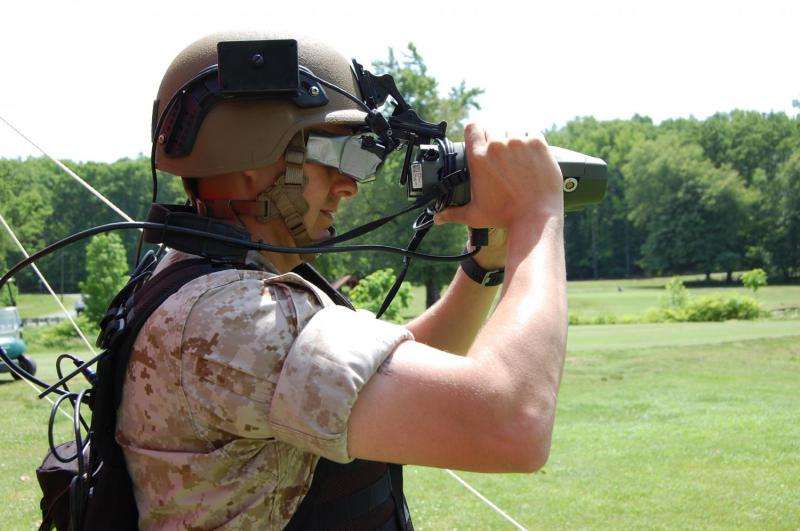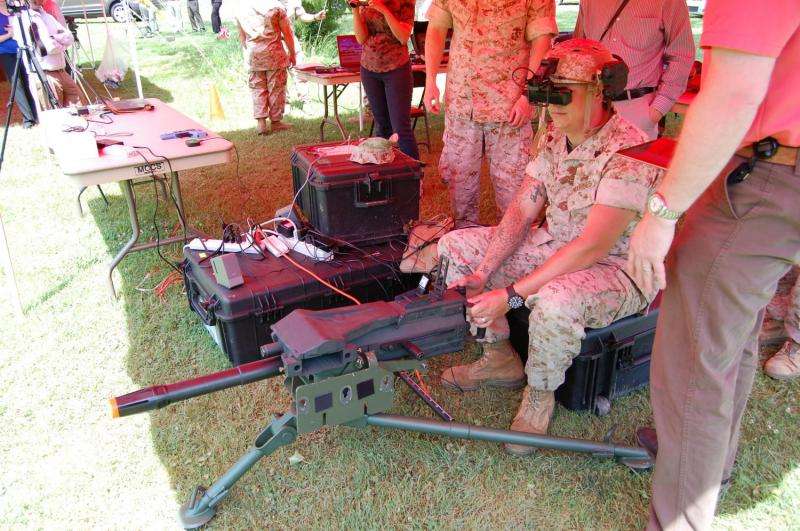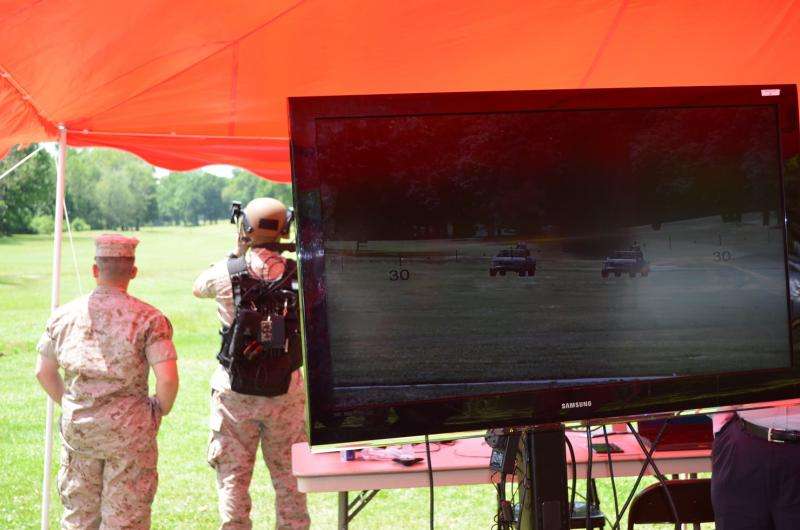A Marine operates the Augmented Immersive Team Trainer system at Marine Corps Base Quantico in Quantico, Virginia, May 21. Credit: Nicole Lemoine, Vencore
Marines were able to turn a lush golf course into a hostile battleground complete with tanks, mortar fire and smoke at a demonstration on May 21 using an augmented reality training system from the Office of Naval Research (ONR).
At Marine Corps Base Quantico in Quantico, Virginia, the Augmented Immersive Team Trainer (AITT) moved one step closer to its ultimate goal of giving warfighters glasses that can be worn to enhance augmented reality training scenarios.
The term "augmented reality" refers to a live environment onto which virtual images are superimposed. Think of watching a football game on television and seeing the yellow first-down line added to the screen you're watching. This is different from "virtual reality," which is a wholly computer-generated environment in which users immerse themselves.
The system, which can support a wide array of live, virtual and constructive training scenarios, is "only limited by the imaginations of those using it," said Dr. Peter Squire, a program officer with ONR's Expeditionary Maneuver Warfare and Combating Terrorism Department.
The glasses, or "optical see-through" components, were recently completed, and this was the first time they were hooked up to the AITT system. Representatives from the Army, Navy, and Marine Corps were present to watch the Marines test out the newest iteration.
"The glasses are leading-edge and are really pushing the technology of optical see-throughs forward," Squire said. "But the glasses are just one component of the system. It's the AITT system itself that's revolutionary because it enables warfighters to turn any environment into a training ground."
A Marine operates the Augmented Immersive Team Trainer system at Marine Corps Base Quantico in Quantico, Virginia, May 21 Credit: Nicole Lemoine, Vencore
The glasses are more technologically advanced than the much-discussed Google glass—a head-mounted display that shows information in a smartphone-like format. Created through a Small Business Technology Transfer program, they have a much larger field of view than similar products that are commercially available. Marine Corps Maj. Le Nolan, an action officer for the Human Performance Training and Education (HPT&E) thrust area in ONR's Expeditionary Maneuver Warfare and Combating Terrorism Department, described them as being like "a portable high definition PC [personal computer] screen in front of your eyes that can integrate and render complex information in a manner that does not exist for the typical heads-up displays Marines use today."
The AITT program, now in its fifth year, will wrap up this fall with a final large-scale demonstration at Quantico. The program then will transition to the Marine Corps Program Manager for Training Systems for further testing and development.
A Marine operates the Augmented Immersive Team Trainer system at Marine Corps Base Quantico in Quantico, Virginia, May 21. The flat-panel screen shows the view the Marine operating the system is seeing: the golf course setting with virtual vehicles superimposed on it. Credit: Eve A. Baker, Staff Writer, Quantico Sentry
"For Marines, this system increases their situational awareness, whether for training or operations, giving them a wider aperture for information to help make better decisions," Nolan said. "And, in the end, that's what we're trying to do here in HPT&E: give warfighters enough information to make the best decision possible, but not overwhelm them with so much information that they can't make sense of it."
The AITT system could be an important tool in achieving the Marine Corps' goal—as stated in the Marine Corps Vision & Strategy 2025—of having training that "accurately reflect[s] the situations, environments and peoples Marines will face" and preparing Marines "realistically for complex conditions" while using resources more efficiently.
More information: www.onr.navy.mil/~/media/Files … ategy_2025_0809.ashx
Provided by Office of Naval Research






















